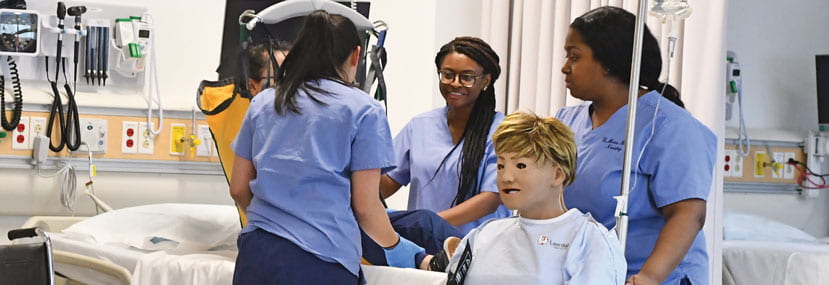
Out with the Old, In with the Leading-Edge–Center for Clinical Education and Research (CCER)
Today, perhaps more than ever in recent memory, skilled nurses are critical, literally, to the health and well-being of our citizenry. UMass Boston’s (UMB’s) recent dismantling and subsequent relocating and building of a state-of-the-art nursing simulation lab gives UMB’s nursing students the confidence and competencies they need to excel. faculty, and staff.
The task for everyone involved was staggering. An archaic 3,000-square-foot lab built in 2008 morphed into a 21st-century, 10,000-square-foot, state-of-the art facility relocated from the old Science Building to the Quinn Administration Building. “Morphed” is a bit of a misnomer, as the move required months of planning, all well worth the effort. Gone the crowded space, outdated mannequins, and antiquated technologies. Here to stay, a teaching and learning center fit for the 21st century.
Rosemary Samia, director of the College of Nursing and Health Sciences’ Center for Clinical Education and Research, called the remake a “game changer” with its four-room simulation suite, six out-patient exam rooms, a 40-seat classroom, 18 station computer labs, and two skills labs each with 10 patient bays.
“When students come into the lab, they are immersed into the sights and sounds of a hospital environment,” said Samia. “We have multiple simulation opportunities for students to practice skills, make decisions, and implement nursing interventions in a safe environment. Dedicated simulation educators monitor students from a control room and program high-fidelity mannequins to provide real-time feedback.”
But this game changer did not happen overnight. The successful project was the result of hard work and close collaborations between Samia and UMB’s IT and facilities teams.
Zack Ronald, systems analyst; John Jessoe, manager of Classroom Technology and AV Services; Jeff Wade, chief audio-visual engineer; and Jamie Soule, director of Network Services, among many others, were all instrumental in transitioning the old lab to its new technologically advanced home. “The collaboration worked well,” said Samia. “I knew what the lab needed to function, but I didn’t know what needed to happen behind the scenes.”
This was a huge effort from multiple IT teams, and from start to finish, it took well over a year. Soule was critical to the planning phase. “In my role, I am liaison with the facilities department,” he said. “When we design spaces on campus, I sit with the design team to ensure we have the right kind of network, fiber optics, and so forth. I helped Rosemary navigate through a lot of the technology needed to make things work. The Sim lab was a huge collaboration with UMB’s facilities team. We’re all very proud of the outcome.”
This project was chockful of nitty-gritty details. Take the highfidelity mannequins as an example. “The mannequins hook up to a system called SimCapture, allowing a student to control them while sending valuable feedback to the instructors in the control room,” said Ronald.
The complexities and expense of the install and technologies compelled the teams not only to think current use, but also look to the future, something Ronald called “future proofing.” “The mannequins hook up to a system called SimCapture, allowing a student to control them while sending valuable feedback to the instructors in the control room.” —Zack Ronald, Systems Analyst
“In every scenario that we run, there is an acute issue that must be addressed immediately by the student,” said Samia. “Depending on a student’s intervention and response time, the ‘patient’ will respond accordingly. In simulation, one of the biggest elements is the debriefing phase that happens afterwards. It’s crucial to explore the questions: ‘What happened during the simulation, why it happened, and what led to the student’s decisions?’”
Ronald said that this project started prior to the formation of the Project Management Office (PMO) and that a PMO would certainly aid in a project of this magnitude. However, he said, “From the very beginning, when you put the right people in place and everyone asks the right questions in the beginning, things go well. In my opinion, the IT aspect of this project went very smoothly.”
CCER During the COVID-19 Lockdown
Prior to UMB’s lockdown in March, students logged in over 36,000 hours in the new lab. But thanks to the creativity of Samia and her team, simulations continue even while students learn from home.
With minimal equipment from the lab and working with Ronald, Samia delivers simulations to students remotely via the university’s Zoom equipment. “We use a shared screen with between 20 and 25 students each session. Students see on the patient monitor the vital signs change in real time based on the decisions they make.”
Then simulation educators—also working remotely—zoom in and present a patient case. “We put an educator in scrubs and use a virtual background to increase fidelity.”